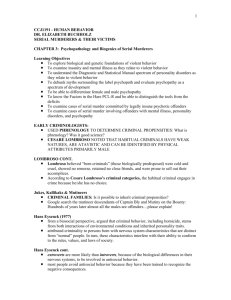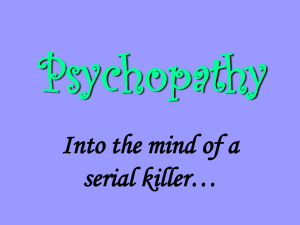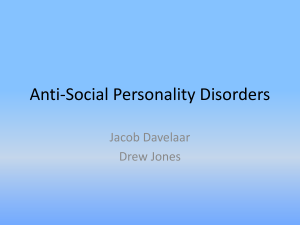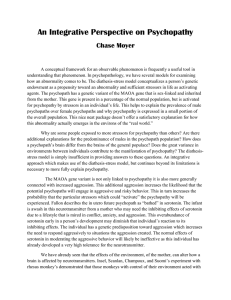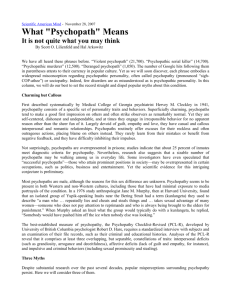Ch. 3 Rev - MDC Faculty Home Pages
advertisement
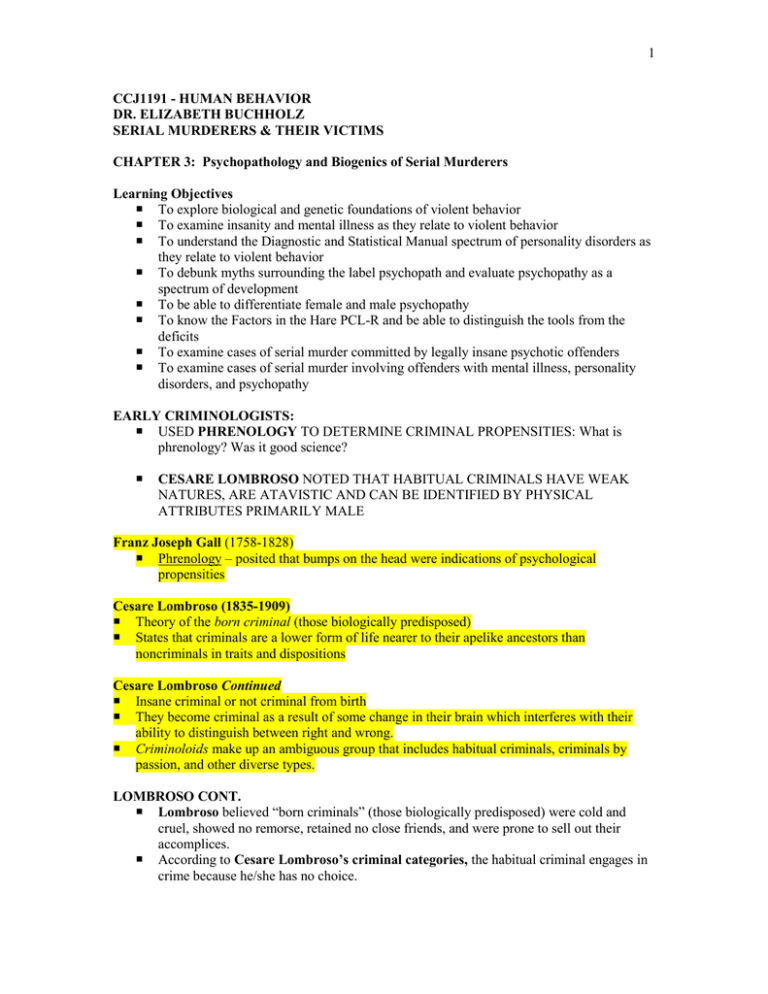
1 CCJ1191 - HUMAN BEHAVIOR DR. ELIZABETH BUCHHOLZ SERIAL MURDERERS & THEIR VICTIMS CHAPTER 3: Psychopathology and Biogenics of Serial Murderers Learning Objectives To explore biological and genetic foundations of violent behavior To examine insanity and mental illness as they relate to violent behavior To understand the Diagnostic and Statistical Manual spectrum of personality disorders as they relate to violent behavior To debunk myths surrounding the label psychopath and evaluate psychopathy as a spectrum of development To be able to differentiate female and male psychopathy To know the Factors in the Hare PCL-R and be able to distinguish the tools from the deficits To examine cases of serial murder committed by legally insane psychotic offenders To examine cases of serial murder involving offenders with mental illness, personality disorders, and psychopathy EARLY CRIMINOLOGISTS: USED PHRENOLOGY TO DETERMINE CRIMINAL PROPENSITIES: What is phrenology? Was it good science? CESARE LOMBROSO NOTED THAT HABITUAL CRIMINALS HAVE WEAK NATURES, ARE ATAVISTIC AND CAN BE IDENTIFIED BY PHYSICAL ATTRIBUTES PRIMARILY MALE Franz Joseph Gall (1758-1828) Phrenology – posited that bumps on the head were indications of psychological propensities Cesare Lombroso (1835-1909) Theory of the born criminal (those biologically predisposed) States that criminals are a lower form of life nearer to their apelike ancestors than noncriminals in traits and dispositions Cesare Lombroso Continued Insane criminal or not criminal from birth They become criminal as a result of some change in their brain which interferes with their ability to distinguish between right and wrong. Criminoloids make up an ambiguous group that includes habitual criminals, criminals by passion, and other diverse types. LOMBROSO CONT. Lombroso believed “born criminals” (those biologically predisposed) were cold and cruel, showed no remorse, retained no close friends, and were prone to sell out their accomplices. According to Cesare Lombroso’s criminal categories, the habitual criminal engages in crime because he/she has no choice. 2 Born criminals have atavistic stigmata, physical features of creatures at an earlier stage of development before they become fully human Cesare Lombroso Continued Criminal characteristics include Huge jaws Strong canine teeth Arm span greater than their height (excessive length of arms) sloping forehead Ears of unusual size Asymmetry of the face Prognathism (an extension or bulging out [protrusion] of the lower jaw) Asymmetry of the cranium Cesare Lombroso Continued Any other "physical stigmata" An individual born with any five of the stigmata is a “born criminal Jukes, Kallikaks & Mutineers CRIMINAL FAMILIES: Is it possible to inherit criminal propensities? Richard Dougdale (1841-1883) Inherited Criminality Criminality is an inherited trait passed on in the genes. Studied the Jukes family Ada Jukes, “mother of criminals” Of the 1,000 descendants Dougdale found 280 paupers, 60 thieves, 7 murderers, 40 other criminals, 40 persons with venereal disease, and 50 prostitutes Dougdale argued that they were transmitting a degenerate trait to the next generation Some states allowed sterilization in early 20th century, and they were held constitutional “It is better for all the world, if instead of waiting to execute degenerate offspring for crime, or to let them starve for the imbecility, society can prevent those who are manifestly unfit from continuing their kind…Three generations of imbeciles are enough.” --Oliver Wendall Holmes Jr., 1927 The Kallikak Family (Henry Goddard) On his way back from battle, the normally morally upright Martin dallied one time with a “feeble-minded” barmaid. He soon reformed and went on with his upright life, becoming a respected New England citizen and father of a large family of prosperous individuals. A child was born by the dalliance with "the nameless feeble-minded girl.” This single child, a male, went on to father more children, who fathered their own children, and on and on down the generations. On the "feeble-minded" side of the Kallikak family, descended from the barmaid, the children wound up poor, insane, delinquent, and mentally retarded. 3 To understand serial killers we must look at them from a variety of avenues. Indeed, childhood experiences can play a tremendous role in the development of violent behavior. Hans Eysenck (1977) from a biosocial perspective, argued that criminal behavior, including homicide, stems from both interactions of environmental conditions and inherited personality traits. attributed criminality to persons born with nervous system characteristics that are distinct from “normal” people. In turn, these characteristics interfere with their ability to conform to the rules, values, and laws of society. Hans Eysenck cont. extroverts are more likely than introverts, because of the biological differences in their nervous systems, to be involved in antisocial behavior. most people avoid antisocial behavior because they have been trained to recognize the negative consequences. INSANITY AND MENTAL ILLNESS As far as the criminal courts are concerned, insanity is a legal term, not a psychiatric distinction and is used to define the state of mind of an offender at the time of the offense. Many mass murderers, unlike serial killers, have a history of mental illness. Most mass murderers were found to have had several major life events that precipitated the murders. TESTS FOR DEFINING INSANITY The M’Naughten Rule Must prove at the time of the committing of the act the party accused was laboring under such a defect of reason from disease of the mind as not to know the nature and quality of the act he was doing Or, if he did know, he did not know he was doing what was wrong. TESTS FOR DEFINING INSANITY The Irresistible Impulse Test Supplements the M’Naughten Rule, which allows an insanity defense when it can be determined that the offender understands the difference between right and wrong yet succumbs to uncontrollable impulses. TESTS FOR DEFINING INSANITY The Brawner Rule, or Substantial Capacity Test Combines the intents of the M’Naughten Rule and the Irresistible Impulse Test The accused only needs to show a lack of substantial capacity as opposed to total impairment. ▪ Excludes repeated criminal behavior (acts committed by sociopaths or antisocial personality disordered people) TESTS FOR DEFINING INSANITY The Durham Rule, known also as the Products Test The accused is not criminally responsible if his unlawful act was the product of mental disease or defect ▪ Criticism: “mental disease” or “defect” leaves juries to rely on psychiatrists’ decisions/definitions 4 TESTS FOR DEFINING INSANITY Read the cases of Joseph Kallinger, the Shoemaker and Edward Theodore “Ed” Gein, American Psycho (1906-1984)(p. 76) MENTAL ILLNESSES/DISORDERS NEUROSIS Mental disorders in which behavior is less violent in nature than those of psychotics. Incudes anxiety disorders, obsessive-compulsive disorders, PTSD, acute stress, substance-abuse disorders. PSYCHOSIS A severe form of mental disease in which the individual suffers from a severe break with reality and may exhibit dangerous behavior. Symptoms include delusions, hallucinations, disorganized speech, grossly disorganized or catatonic behavior. Psychotic vs. Psychopath Psychotic. This means a person has lost touch with reality. Psychopath. This is a personality trait that includes a total lack of empathy for others and amoral/antisocial behavior. MENTAL ILLNESSES/DISORDERS DISSOCIATIVE DISORDERS: 1. Dissociative Identity Disorder a. Presence of two or more distinct identifies or personality states (multiple personality disorder) b. “UFO of psychiatry”—little evidence to support multiple personalities as a true disorder c. Some people avoid or escape stressful or painful experiences d. More common among women MENTAL ILLNESSES/DISORDERS 1. Dissociative Identity Disorder cont’d e. Wilbur—Personalities diagnosed as dissociative had been battered as children ▪ Stress fuels anxieties, then dissociative response to adapt to intolerable situation f. More likely to be used as a decoy defense than to be valid (Kenneth Bianchi, p. 79) Kenneth Bianchi Bianchi and his cousin Angelo Buono, Jr., together are known as the Hillside Stranglers. He is serving a term of life imprisonment in Washington. Bianchi is also a suspect in the Alphabet murders, three unsolved murders in his home city of Rochester. MENTAL ILLNESSES/DISORDERS DISSOCIATIVE DISORDERS: 2. Dissociative Amnesia a. Loss of memory due to psychological reasons rather than organic problems. 1) Triggered by highly stressful events (war, natural disasters) 5 2) Experience anterograde amnesia (loss of memory after a traumatic experience) DISSOCIATIVE DISORDERS: 3. Dissociative Fugue 1) Disturbed state of consciousness in which the one affected seems to perform acts in full awareness but upon recovery cannot. 2) Sudden, unexpected travel away from home or one’s customary workplace with inability to recall one’s past. Hannah Upp, a teacher from New York, went missing on August 28, 2008. She was rescued from the New York Harbor on September 16 with no recollection of the time in between. The episode was diagnosed as dissociative fugue. DISSOCIATIVE DISORDERS: 4. Depersonalization Disorder a. Feeling detached from one’s mental processes or physical body 1) “Out-of-body experience” 2) Splitting off, blocking out, or not remembering undesirable memories (repressing) Psychoanalytic Factors Sigmund Freud Linked abnormal behavior to mental problems induced by early childhood trauma Mind is constantly engaged in balancing the three-part personality structure of id, ego, and superego ▪ Id—primal component of a person’s mental state, driving force for the necessities to sustain life, such as food, water, and sex ▪ Ego—serves to guide an individual’s behavior to conform to rules, laws, and community standards. ▪ Superego—the composite of moral standards and values learned within the family and community. Sits in judgment of a person’s behavior. Henry Lucas Was involved in a dispute with his 15-year-old lover and confidante. In anger, she reached over and slapped him, who responded by stabbing her repeatedly until she was dead. August Aichorn Latent Delinquency A state in which a youth constantly seeks immediate gratification while neglecting the feelings or needs of others Centers on a lack of remorse or sense of guilt in satisfying instinctive urges David Abrahamsen The Murdering Mind All murderers are intensely tormented and are constantly beset by inner conflict Emphasized psychosexual factors 6 Sexual traumatizations may later surface as aggressive, sometimes homicidal behavior FRUSTRATION “Frustration is the wet nurse of violence.” DR. DAVID ABRAHAMSEN IN THE MURDERING MIND Frustration is not an emotion but rather a state of being that often leads to emotions such as anger, sadness or depression. In order for frustration to occur, a person must have some hope for goal attainment. (Either tangible like having more money or intangible as in intimacy with another person) CASE EXAMPLE: Years ago a patient named Calvin executed his college roommate with a shotgun blast to his head while he slept. The roommate had told Calvin not to use his laundry detergent, that he would have to purchase his own. Prior to the killing that evening Calvin had been reading Dr. Abrahamsen’s book, The Murdering Mind and said that he had been fantasizing about killing someone for a long time. What prompted Calvin to kill? Personality Disorders Personality disorder patterns are commonly manifested in two or more of the following ways: Cognition Perception and interpretation of self, other people, and events Affectivity Range, intensity, and appropriateness of emotional response Interpersonal functioning Impulse control Paranoid A pervasive distrust and suspiciousness of others Schizoid A pervasive pattern of detachment from relationships Limited expression of emotions Schizotypal Social and interpersonal deficits, eccentric behaviors that inhibit the development of close relationships Personality Disorders Antisocial Extreme disregard and violation of the rights of others Borderline Instability in interpersonal relationships and self-image, and extreme impulsivity Histrionic Excessive emotionality and attention seeking Narcissistic Grandiosity, need for praise, lac of empathy 7 Personality Disorders Avoidant Social inhibition, feelings of inadequacy, hypersensitive to criticism Dependent Need to be cared for, fear of abandonment, submissive and clinging Obsessive-compulsive Preoccupation with orderliness, perfectionism, mental and interpersonal control, inflexible and inefficient behavior Personality Disorders Are the most resistant to change. Antisocial Behavior Common among violent offenders. Behaviors include Incorrigibility Theft Fighting during childhood Deceitfulness Excessive alcohol/drug use Reckless regard for safety of self or others Impulsivity Aggressive behaviors during adolescence Antisocial Behavior Demonstrate poor work habits Lack of responsibility View the world in negative, hostile terms Frequently show lack of insight into their problems and future plans Trolley Quandary Five persons are about to be killed by a runaway trolley By pushing a large man off a bridge into the trolley’s path, the man will die but the five others will be spared What do you do? Trolley Quandary By pulling a lever to divert the train, the man will die but the five others will be spared What do you do? Trolley Quandary Most people studied would be willing to pull the lever, but not willing to push the man onto the tracks to save others. Psychopaths lack attachments to groups or individuals and would do either. Asperger’s Disorder Silva, Ferrari, and Leong Tendency for isolation from others Repetitive thinking and behaviors A pattern of actively rejecting other people’s worldviews even when the others make themselves available for potential social interaction 8 Ted Kaczynski: The UnABomber “In order to get our message before the public with some chance of making a lasting impression, we had to kill people.” Entered Harvard at age 16 Received doctorate from U of Michigan Hotbed of student radicalism in the 60s Taught at UC Berkeley Poor student reviews (unapproachable) After 2 years resigned, moved into a cabin in Montana—lived in total isolation Over the years, he developed his own anti-government and anti-technology philosophy Returned to Chicago to work with brother in a factory Had a failed relationship with a female supervisor Made first homemade bomb, sent to Northwestern University professor, but was opened by a campus security officer, who was injured Tried again following year Then targeted American Airlines with two bombs, addressed to company president Sent bomb to Vanderbilt University, secretary injured Sent bomb to UC Berkeley, Assistant Professor injured First killing, a California computer store owner (found package in back of parking lot) Two others killed, NJ & CA In total, 3 killed, 22 wounded Big break in the case came when Kaczynski sent out a 35,000-word essay on the problems of modern society Threatened media outlets, such as The New York Times and Washington Post, to publish his so-called "Unabomber Manifesto,” or would blow up a plane Brother, David Kaczynski, read the manifesto, and suspected that the Unabomber was his brother Recognized the writing style and some of the ideas expressed as Ted's. Eventually shared his suspicions with the authorities Psychopath Cleckley’s The Mask of Sanity Intelligent Rational Calm Unreliable Insincere Without shame or remorse Having poor judgment Without capacity for love Unemotional Poor insight Indifferent to the trust or kindness of others Overreactive to alcohol Suicidal Impersonal sex life 9 Lacking long-term goals Inadequately motivated antisocial behavior PSYCHOLOGICAL FACTORS in PSYCHOPATHY Control/Power Loving and hating are similar forms of attachment Frustration/Aggression Fantasy Abandonment/Rejection Intimacy: The holy grail of being human Hare’s PCLR Factor 1: Measures a selfish, callous, and remorseless use of others. Hare’s PCLR: FACTOR 1 or “Tools” of the Psychopath Glibness/superficial charm Grandiose sense of self-worth/narcissism Pathological lying Conning, manipulative behavior Lack of remorse or guilt Shallow affect Callousness/lack of empathy Failure to accept responsibility for actions Hare’s PCLR Factor 2: Measures social deviance, as manifested in a chronically unstable and antisocial lifestyle. Hare’s PCLR: FACTOR 2 or “Deficits” of the Psychopath Need for stimulation/proneness to boredom Parasitic lifestyle Poor behavioral controls Early behavioral problems Lack of realistic, long-term goals Impulsivity Irresponsibility Juvenile delinquency Revocation of conditional release Many short-term marital relationships Criminal versatility These factors vary with age, social class, cognitive abilities, alcohol and drug abuse or dependence, violent behavior, and recidivism of the psychopath. Factor 1 measures are tools used by the psychopath to achieve his main purpose: control. Factor 2 measures are more deficits of the psychopath—things that his tools will conceal through lies and manipulations. SOCIOPATHS AND PSYCHOPATHS ARE DISTINGUISHED BY SKILL LEVELS INTELLIGENCE EXPERIENCE 10 Psychopaths become adept at psychological game playing and ultimately become proficient at controlling their environment. This is usually not true of the sociopath. GENERAL COMPARISON OF SOCIOPATHS TO PSYCHOPATHS SOCIOPATHS Long history of criminal behavior Average to below average intelligence Anti-social Explosive temperament Limited in social skills PSYCHOPATHS Average to above average intelligence Little or no criminal history Anti-social Adaptive social skills Limited or no visible emotional responses PRIMARY (Advanced) PSYCHOPATHS ABOVE AVERAGE TO HIGHLY INTELLIGENT SOCIAL CHAMELIONS VAGAL-REACTORS: Persons who can beat the polygraph because they have no galvanic skin response. They are calm at the moment of the kill. ANTI-SOCIAL COMPULSIVE LIARS COMSUMMATE PREDATORS Female Psychopaths It is difficult to distinguish psychopathy from other personality disorders that have similar core traits. Female psychopaths appear to lean toward “histrionics”—deliberate displays of emotion—rather than the narcissism commonly found in male psychopaths. “The Nightmare Nurse” “This is my ambition—to have killed more people—more helpless people—than any man or woman has ever killed.” —Jane Toppan The PCL-R and Female Serial Killers Female serial murderers appear to exhibit some traits similar to those of male serial murderers in terms of psychopathology. The women tend to be insincere, amoral, impulsive, prone to exercise manipulative charisma and superficial charm, without conscience, and with little insight because they failed to learn from their mistakes. Measuring Criminal Psychopathy Hare’s Psychopathy Checklist Revised (PCL-R) On a 40-point scale, normal persons rate about a 5, a typical incarcerated male offender rates about 23, while bona fide psychopaths rate at 30 points or higher. Persons with high PCL-R scores are 3 times more likely to recidivate than persons with low scores. 11 Measuring Criminal Psychopathy Factor 1: Measures a selfish, callous, and remorseless use of others. Inferred traits include— Glibness/superficial charm Grandiose sense of self-worth/narcissism Pathological lying Conning, manipulative behavior Lack of remorse or guilt Shallow affect Callousness/lack of empathy Failure to accept responsibility for actions Measuring Criminal Psychopathy Factor 2: Measures social deviance, as manifested in a chronically unstable and antisocial lifestyle These traits are more explicit, and include— Need for stimulation/proneness to boredom Parasitic lifestyle Poor behavioral controls Early behavioral problems Lack of realistic, long-term goals Impulsivity Irresponsibility Juvenile delinquency Revocation of conditional release Promiscuous sexual behavior Many short-term marital relationships Criminal versatility Signature or master tool of a psychopath: Tools used to differentially gain control over others ▪ Financial ▪ Sexual ▪ Emotional ▪ Physical The psychopath uses distraction to “remain hiding in plain sight.” Ponzi schemes (see Madoff, p. 96) Luring children with puppies (“lost puppy”) Distraction is such a powerful tool that actual violence is used only by certain types of psychopaths for specific purposes. Criminal psychopaths are more dangerous than most other people, but research indicates most are not violent. They appear to be more prone to violent behavior than other people. 12 Jacobson’s “Vagal Reactors” Found men who were antisocial abusers had a different physiological response to conflict than other men in similar circumstances. Their heart rates decline during heated arguments that involve emotionally aggressive confrontations. The decrease in heart rate is a result of being in control of another person—common to psychopaths who seek control. Psychopaths have a need to control or have power over others—their social an physical environment. Psychopaths are dangerous because they constantly seek control over others. Violent psychopaths seek to release their frustrations by finding someone to kill. Psychopaths are not amenable to treatment because they do not believe they need; in fact, they simply add what they learn to their arsenal of psychological tools that they can later use to control other Psychological treatment must appeal to their self-interests, not emotionality. Psychopaths do not fear pain or consequences. Insight on psychopaths… They are likely to engage in conflicting self-image struggles (Campbell). They live in a “presocialized emotional world” in which feelings are experienced only in relation to self and never to others (Meloy). They show significant impairment on social contract roles (Ermer and Kiehl). Catathymic Crisis (Wertham) A person with underlying emotionally charged conflicts develops a fixed idea that he must kill future victim. (Carry out a violent act.) Two forms: Chronic (lasts from several months to more than a year) or Acute (sudden, short course) The “crisis” involves the superficially integrated person who struggles with inadequacy, specifically sexual inadequacy. The person resorts to violence when potential victims challenge his sense of integrity, adequacy, or sexual competence. Compulsive Homicides (Schlesinger) May be induced by underlying conflict, but are motivated by psychogenic (originating from the mind) sources, with little environmental influence. Are opportunistic or methodically planned. Have strong potential for repetition. Ritualistic acts are sexually motivated, and act of aggression itself is eroticized. The better a person’s self-concept, the higher an individual’s self-esteem, the less need he/she has to control and dominate others. A Psychopath’s Brain Is Different Researchers have learned that a psychopaths brain structure is significantly different from others. University of Wisconsin-Madison researchers discovered the variance studying images of prisoners’ brains (2011). 13 The study showed that psychopaths have reduced connections between the ventromedial prefrontal cortex (vmPFC), the part of the brain responsible for sentiments such as empathy and guilt, and the amygdala, which reconciles fear and anxiety. The study showed directly – that there is a specific brain abnormality associated with criminal psychopathy. RELATED MOVIES TO WATCH A BEAUTIFUL MIND (True story of a brilliant man who was schizophrenic) DIRTY FILTHY LOVE (Story of a man with OCD and Tourette’s Syndrome). PRIMAL FEAR ( Story of an alter boy who murders a priest) BLACK SWAN ( Story of a delicate ballet dancer who slips into insanity). NOTES ON A SCANDAL ( A story of female psychopathology) AMERICAN PSYCHO (Story of a narcissistic banking executive who gets lost in the dark side of fantasy). RELATED WEBSITES Cornell University Law School Legal Information Institute: Insanity Defense: www.law.cornell.edu/wex/insanity_defense Without Conscience": Robert Hare's Web Site devoted to the study of Psychopathy: www.hare.org The Madoff Recovery Initiative: www.madoff.com.
